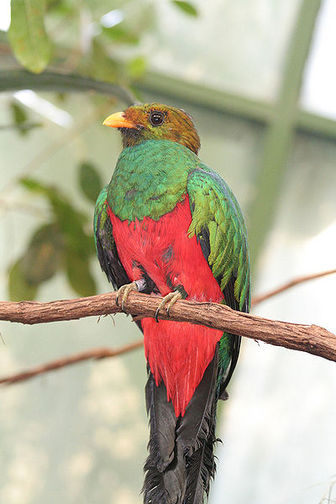Golden-headed Quetzal
Males and females are approximately the same size, having a total length of ca. 35 cm and a weight of 160 g. as adults. Adult males are iridescent green with a golden cast to their heads, black wings, bright red bellies, and a yellow bill. The female is duller with a greyer head and lower chest and a dusky bill. Both sexes have an entirely blackish undertail unlike the Crested Quetzal.

Original source: Flickr user chdwckvnstrsslhm . Photo uploaded to commons by user ltshears
Author: Flickr user chdwckvnstrsslhm . Photo uploaded to commons by user ltshears
The Golden-headed Quetzal is classified as Least Concern. Does not qualify for a more at risk category. Widespread and abundant taxa are included in this category.
The Golden-Headed Quetzal (Pharomachrus auriceps) is a colorful bird native to highlands forests in South America. Contents - * 1 Description * 2 Habitat and behavior * 3 References * 4 External links Description - Closeup of a male Golden-Headed Quetzal. More
The Golden-Headed Quetzal (Pharomachrus auriceps) is a colorful bird native to South America. Description Size: Males and females are approximately the same size, reaching up to 35cm in length and 160g in weight as adults. Adult males are iridescent green with black wings, bright red bellies, and a golden cast to their heads. Their beaks are yellow. Females are slightly duller in appearance. More
Golden-headed Quetzals occur in the Andes of Venezuela, Colombia, Ecuador, Peru, and Bolivia. They live in humid highland forests and are uncommon to locally fairly common. They are solitary, seasonally monogamous birds which share the 18-day incubation period of their two eggs and the feeding of their offspring during the fledging period of 25 to 30 days. The nest is usually placed in a hollow in an old tree. Their diet mostly consists of fruit and insects, with the occasional small lizard. More
breed the golden-headed quetzal in captivity. Since the first hatching at the Zoo in October 1985, there have been nine nestings. Of the 17 eggs, 15 hatched and 11 birds successfully fledged. The golden-headed quetzal is not threatened in the wild yet, though parts of its range are being deforested; however, the closely related resplendent quetzal is endangered. The methodology developed for propagation of the golden-headed quetzal would be applicable to the resplendent quetzal should captive propagation become necessary. More
Golden-headed Quetzal (Pharomachrus auriceps) by Don Jones. More
Family : Trogonidae
Genus : Pharomachrus
Species : auriceps
Authority : (Gould, 1842)

